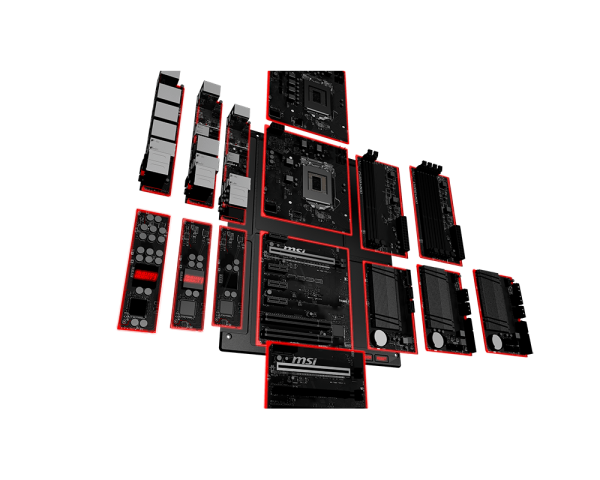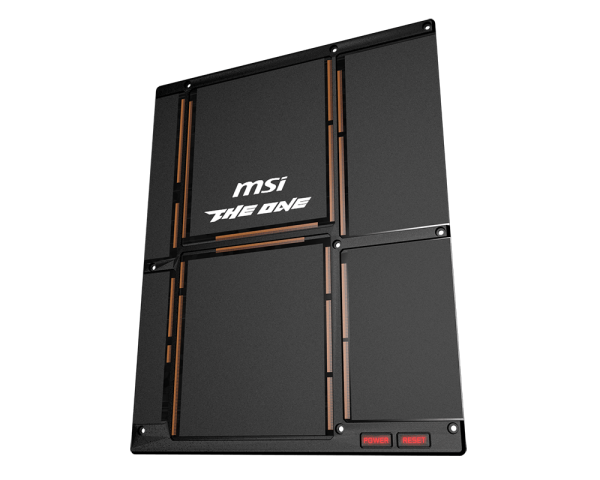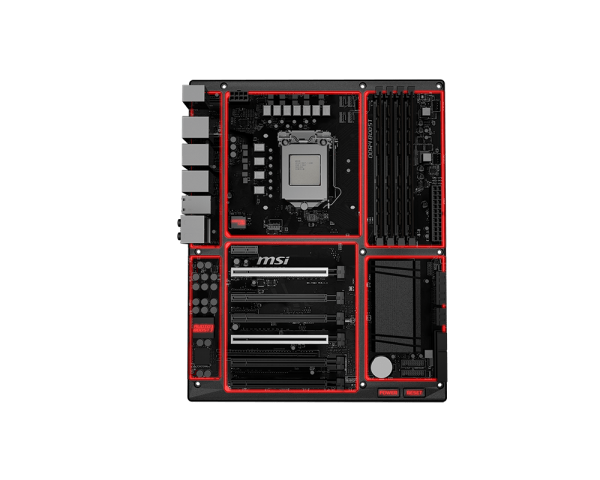Modular Motherboard? An April Fools' Joke With Actual Promise
MSI sent out an April fools joke about a modular motherboard capable of supporting both Intel and AMD processors. Although the company doesn’t have any serious plans to produce motherboards like this--seriously, it’s an April Fools' joke--it did lead us to ponder the concept of a modular motherboard and how amazing that could be.
Using MSI’s fake product design as an example, a board could be split into seven modular components, or “slices,” for lack of a better term: rear I/O, CPU socket and power regulation hardware, PCI-E connections, RAM, chipset with SATA and other internal headers, and finally a base to interconnect all of the pieces together.
How Is It Useful?
If you think about it, this has seemingly endless upgrade potential. Say for example you buy an Intel-based system with a motherboard that initially has only 4 SATA III (6Gbps) ports, two DDR3 RAM slots and no M.2 connection. If you wanted to improve any of these features today, you would need to buy an entire new motherboard. That motherboard replacement may improve on some features over your old one, but you may find yourself having to make other compromises, thereby making the “upgrade” more of a “side step.”
If that motherboard was modular, you could simply purchase a new RAM slice that supports DDR4 and swap out the old DDR3 one. This would reduce your overall upgrade cost, even as you significantly improve your system performance overall.
Further, many enthusiasts may not want to have on-board audio, preferring to use HDMI, DP or USB-based audio devices. In this scenario, an enthusiast could simply not buy an on-board audio solution and use the savings for other components.
Returning to MSI’s original joke, you could theoretically migrate from an Intel system to an AMD system (or vice versa) by swapping out the chipset and socket motherboard slices and keeping the RAM, PCI-E, audio, rear I/O and base mounting plate. This would make the transition considerably less expensive, as you would be buying considerably less hardware.
Is It Possible?
Technically, we believe such a thing is possible. Granted, developing a modular motherboard would require a group of exceptionally innovative engineers that would have to design a standardized way for all of these components to interconnect and function properly, but from what we’ve heard from people in the know, there isn’t anything that would make it inherently impossible.
Get Tom's Hardware's best news and in-depth reviews, straight to your inbox.
Connecting the two most important slices (the chipset and CPU socket) in a modular way should be easy. Most of Intel’s current Skylake chipsets, for example, already use the same DMI 3.0 connection between the CPU and PCH. Therefore, a modular motherboard wouldn’t even need a change in the transmission standard or number of wires; it would simply need a few extra electrical contacts so the separate PCBs could be connected together.
Connecting the RAM slice to the CPU socket slice would be slightly more difficult, as the CPU socket section would need to have all of the wire contacts required for both DDR3 and DDR4, whereas OEMs place only one of the two sets of wire connections in a board now. It would require some minor alterations to the layout and design of the pathways between the memory and the CPU, but the signaling and transmission standards wouldn’t need to change. This should be relatively simply for an OEM to develop.
What would by far be the most difficult part to design are the rear I/O and PCI-E slices, actually. This is partially because the different connections used on AMD and Intel boards aren’t entirely the same, so it would be difficult to design modular motherboard components to work for both. This is not to say that they aren't shared standards; it's just that there is a seemingly endless number of different connections that could be incorporated on these slices and the connectivity support each chipset features.
For example, on Intel's Z170 chipset, there are 20 HSIO lanes from the chipset that can be configured for several different components, such as SATA, USB or PCI-E. OEMs frequently connect multiple devices to each lane, using firmware logic to disable one device if another is in use, but these connections are ultimately interfacing with the same pins on the PCH. AMD's top end 990FX chipset, however, features 38 PCI-E lanes, which allows it to support nearly twice as many connections at the same time. Developing modular rear I/O and PCI-E slices that can effectively use the max number of connections for both increases the design complexity of the system, and would take considerably more resources to work out.
A company could start by simply designing modular parts designed specifically for AMD and Intel that aren’t compatible with each other, as this would carry with it considerably benefits alone, but it doesn’t get around all of the problems with designing interchangeable rear I/O and PCI-E components.
The greatest challenge would be developing a method that permits the chipset to detect and appropriately connect to the PCI-E and rear I/O slices. The chipset can support a wide number of connections, motherboard OEMs often add more connections than the PCH can handle, and the number and arrangement of these devices would be completely unpredictable. An OEM could make all of the physical connections available and then design a firmware extension to UEFI to auto-detect and configure these devices.
But of course, it’s easier said than done. For now, the dream of a modular motherboard is an entirely theoretical concept that has yet to be developed or tested (as far as we know). We may never see such boards come into existence, but it’s certainly worth having the discussion. Perhaps if motherboard OEMs see significant-enough interest for such a modular motherboard, it could spark something real.
Follow Michael Justin Allen Sexton @EmperorSunLao. Follow us onFacebook, Google+, RSS, Twitter and YouTube.
-
jimmysmitty While interesting this would be very hard. Problem is the pinouts for Intel and AMD are different as are what they support on chip vs on chipset. If you wanted to switch from Intel to AMD or vice versa you would also have to swap out most of the other modular parts to get it to properly work.Reply
Would be cool though just very hard. -
Turb0Yoda And what about BiOS. That would also have to be switched out, and that would most likely cause problems with the host OS.Reply -
gggplaya Bios wouldn't have to be swapped out. Bios manufacturers would simply need to implement code for either case and have autodetection to implement the correct code.Reply
The modular motherboard will have other challenges in performance and bandwidth. Seperating everything into modular peices will introduce noise and more latency. You won't be able to clock things as high and the motherboard will be slower. -
tiagoluz8 let's go back to this then: http://vintagecomputer.com/wp-content/uploads/2012/01/IMSAI-8080-inside.jpgReply -
IInuyasha74 Reply17751061 said:And what about BiOS. That would also have to be switched out, and that would most likely cause problems with the host OS.
Like gggplaya said, the BIOS wouldn't need changed really, but things would be different. It would need some serious UEFI BIOS innovation to make it able to autodetect all the different hardware components. Essentially what they would do is make a primary BIOS on the same slice as the chipset, and then they would put simpler chips containing universal firmware information on all of the other slices. The primary BIOS would need to load and configure it all, but it is very possible.
@gggplaya: It wouldn't hamper performance or bandwidth at all. Nearly all of the connections already exist as hard wires, they would just need to put a break in the wire, and then have the base slice complete the connection. It would work exactly the same as current motherboards in that way. It also wouldn't have any effect on clock speed at all. There might be slightly higher latency because of the firmware changes that need made, but it is doubtful that it would have any significant impact. -
The Wizzard What you're almost describing is PICMG:Reply
https://www.picmg.org/openstandards/shb-express/
It's a modular CPU carrier which connects to a backplane / bus for all PCI/PCIe connections (in PICMG 1.3). It's capable of full or half size (roughly eATX width, to ITX width) and doing a "platform" upgrade only consists of swapping one card for another. Basic I/O could easily be migrated to the carrier board via PCIe.
I doubt you'll see modular RAM carrier sockets in the consumer world, but they do exist for servers for sure. -
InvalidError In the 90s, I think it was Gateway which actually had a modular motherboard: the top half holding the CPU socket, chipset, rear IOs, memory, cache, BIOS and a few other things, the other part providing all of the IOs over PCI and power.Reply


